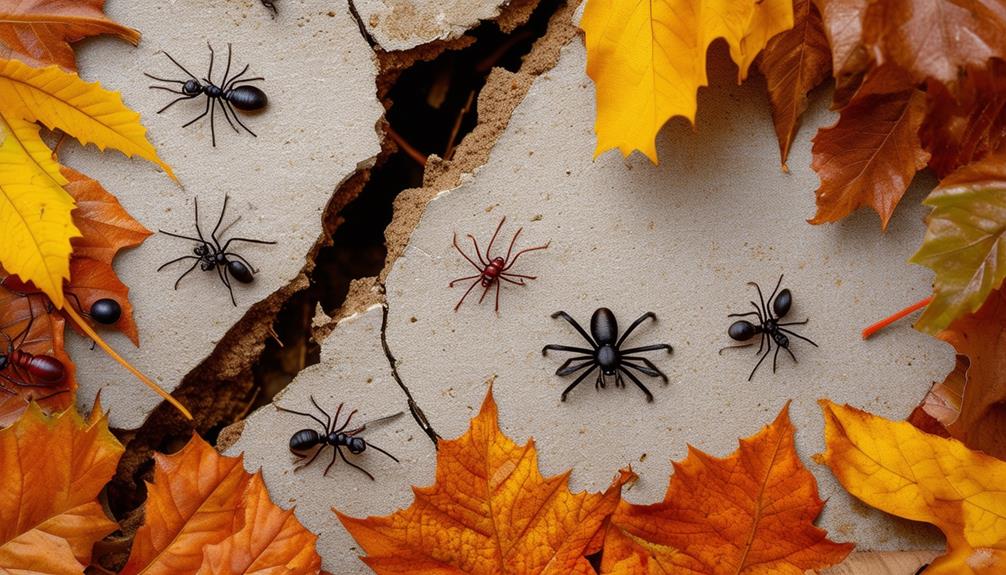When considering educating your community about pest prevention, it is crucial to start by understanding the impact pests can have on daily life. By recognizing the various risks associated with pest infestations, you can take proactive steps to safeguard your home and surroundings. But what are the key strategies that can effectively prevent pests from invading your community? Stay tuned to learn more about practical tips and expert advice on how to tackle this common challenge head-on.
Key Takeaways
- Conduct community workshops on pest identification and prevention methods.
- Distribute educational materials on common household pests and prevention tips.
- Organize hands-on demonstrations of pest control techniques.
- Collaborate with local pest control experts for insights and guidance.
- Empower residents with knowledge on sustainable pest management practices.
Importance of Pest Prevention
Understanding the significance of pest prevention is essential for safeguarding community health and well-being. Pest prevention plays an important role in reducing health risks associated with pests and the harmful effects of pesticides in communities.
By implementing pest prevention measures, you can effectively avoid property damage and costly pest infestations. It’s critical to educate the community about pest prevention as this empowers individuals to take proactive steps in managing pests.
Unlike simply treating the symptoms of pest problems, pest prevention efforts focus on addressing the root causes, leading to long-term solutions. Through effective pest prevention strategies, safer and healthier environments can be created for all community members.
Identifying Common Household Pests
You must be aware of common household pests such as cockroaches, ants, rodents, bed bugs, and flies. Identifying these pests accurately is crucial for successful pest control measures.
Understanding the signs of infestation early on can help you take prompt action to prevent damage and health risks in your home.
Pest Identification Tips
Identifying common household pests involves closely observing physical characteristics, behavior patterns, and typical habitats to effectively differentiate between various species. Recognizing signs of pest activity such as droppings, gnaw marks, and shed skins is essential for accurate identification. Below is a table to help you distinguish between common household pests:
| Pest | Physical Characteristics |
|---|---|
| Cockroaches | Flat bodies, long antennae |
| Ants | Thin waist, elbowed antennae |
| Rodents | Long tails, sharp front teeth |
| Bed Bugs | Flat, reddish-brown, oval |
| Spiders | Eight legs, two body segments |
Understanding these distinguishing features will aid in early detection and the implementation of appropriate pest control measures.
Common Household Bugs
Common household bugs, such as cockroaches, ants, spiders, silverfish, and bed bugs, play significant roles in the ecosystem and can impact human health and well-being.
Among these pests, bed bugs stand out for their feeding habits on human blood. Identifying bed bugs is essential as they’re adept at hiding in cracks and crevices near sleeping areas. These nocturnal insects can cause itchy welts and emotional distress.
To detect bed bugs, look for small reddish-brown insects, molted skins, and tiny dark spots on bedding or furniture. Early detection and intervention are key to preventing bed bug infestations from spreading and causing discomfort in your home.
Remember to consult pest control professionals for effective bed bug eradication strategies.
Risks of Pest Infestations
Pest infestations pose significant risks to communities, encompassing property damage, health hazards, and various nuisance issues. Rodents such as mice and rats are known carriers of diseases like salmonellosis, posing essential health risks to humans. Additionally, these pests can cause structural damage by gnawing on wires and wooden structures.
Insects like cockroaches and mosquitoes can trigger asthma attacks, transmit diseases such as West Nile virus, malaria, and Zika virus, and contaminate food sources, leading to foodborne illnesses. Bed bugs, another common pest, can cause sleep disturbances, skin irritations, and psychological stress in those affected. These risks highlight the importance of implementing effective pest prevention methods in communities.
Educating individuals on proper sanitation practices, eliminating standing water sources, sealing entry points, and maintaining a clean environment are key steps to mitigate the negative impacts of pest infestations. Preventative measures play an integral role in safeguarding community members from the dangers associated with pest presence.
Benefits of Integrated Pest Management
Have you ever wondered how Integrated Pest Management (IPM) can revolutionize pest control practices in your community? IPM offers a sustainable and environmentally responsible approach to pest management by reducing the need for repeated pesticide applications. By addressing the root causes of pest issues, such as eliminating food and water sources or sealing entry points, IPM focuses on long-term prevention rather than just treating the symptoms.
This method emphasizes selecting the safest and most effective control strategies based on the specific information about the pests present. IPM is especially important for the health and safety of children, who are more vulnerable to the harmful effects of pesticides. Schools and communities benefit greatly from IPM as it provides safe and efficient solutions to pest problems without compromising human health or the environment.
To successfully implement IPM strategies, understanding the behavior and biology of pests is essential. By adopting Integrated Pest Management practices, communities can achieve sustainable pest control while safeguarding the well-being of their residents.
Practical Pest Prevention Tips
Inspecting and sealing cracks in buildings is vital as it prevents pests from entering your home.
Proper garbage disposal practices are essential in eliminating food sources that attract pests.
Educating your community on reducing clutter can discourage pests from taking up residence in your surroundings.
Simple Pest Control Methods
To effectively deter pests from your surroundings, make sure to regularly dispose of garbage with securely closed lids. Additionally, removing clutter eliminates hiding spots for pests, reducing their presence.
Sealing cracks and holes in buildings is essential to prevent pests from entering indoors. Implementing biological, chemical, and physical control approaches can effectively manage pests.
Remember, proper sanitation practices play an important role in deterring pests by removing their food, water, and shelter sources.
- Regularly dispose of garbage with closed lids
- Remove clutter to eliminate hiding spots
- Seal cracks and holes in buildings
- Implement biological, chemical, and physical control methods
Effective Home Remedies
When addressing pest issues at home, incorporating effective home remedies can greatly aid in practical pest prevention. Integrated Pest Management (IPM) techniques emphasize the use of natural and sustainable solutions to control pests without relying solely on chemicals. Here are some simple yet effective home remedies to keep pests at bay:
| Home Remedy | Pest Targeted | Method of Application |
|---|---|---|
| Peppermint oil | Spiders and ants | Apply a few drops near entryways |
| Diatomaceous earth | Cockroaches and crawling insects | Sprinkle in cracks and crevices |
| Cucumber slices or peels | Ants | Place near entry points |
| Vinegar spray | Flies | Spray on surfaces |
| Marigolds | Mosquitoes and aphids | Plant in garden |
Using these home remedies as part of your pest prevention strategy can help maintain a healthy and pest-free environment.
Engaging Community Workshops
Engage your community in hands-on learning experiences by participating in interactive workshops focused on effective pest prevention techniques. These workshops offer a unique opportunity for residents to explore the world of pest control and prevention.
Here’s why community workshops are beneficial:
- Hands-On Learning: Residents can actively participate in setting up traps and identifying common pests’ entry points.
- Expert Guidance: Experts lead the workshops, demonstrating proven pest control methods for effective prevention.
- Community Engagement: Workshops foster a collaborative environment where community members can share knowledge and experiences.
- Practical Application: Residents learn to identify pest hotspots and implement preventive measures in real-life scenarios.
Reporting and Seeking Help
Instruct community members on the importance of promptly reporting sightings of pests to prevent potential infestations. Vital reporting plays a significant role in addressing pest issues effectively. Encourage community members to report any pest sightings promptly to prevent infestations from spreading and causing further damage. Providing resources and contacts for seeking help with pest control problems is essential for swift intervention. Collaborating with local pest control professionals can offer guidance and assistance in managing pest issues efficiently.
Emphasize the significance of early reporting to tackle pest problems before they escalate. Educate community members on the signs and risks associated with different pests to enhance reporting accuracy. Understanding the behavior and characteristics of common pests enables better identification and reporting. By reporting pest sightings promptly, community members contribute to a proactive approach in pest management, helping to maintain a pest-free environment for all. Remember, swift reporting is key to preventing pest infestations and ensuring a healthier community.
Sustainable Pest Control Methods
Utilizing sustainable pest control methods is imperative for ensuring long-term environmental preservation and human safety. By implementing Integrated Pest Management (IPM) strategies, communities can effectively manage pests while minimizing risks to the environment.
- IPM Program: Integrated Pest Management is a holistic approach that combines various methods to control pests effectively.
- Prevention: Focus on preventing pest infestations through practices such as sealing entry points and maintaining cleanliness.
- Habitat Modification: Altering the environment to make it less hospitable for pests, reducing the need for chemical interventions.
- Biological Controls: Introducing natural predators or using beneficial insects to manage pest populations in a sustainable manner.
These sustainable pest control practices not only help in reducing the reliance on harmful chemicals but also contribute to maintaining a healthy ecosystem and preserving biodiversity within the community.
Involving Local Pest Control Experts
When involving local pest control experts, you gain access to expert advice sessions, hands-on workshops, and pest control demonstrations tailored to your community’s specific needs.
These professionals offer valuable insights into local pest behavior, infestation patterns, and effective prevention methods.
Expert Advice Sessions
Engaging with local pest control experts in expert advice sessions enhances community understanding of pest behavior and effective prevention strategies. These sessions are essential for empowering individuals to combat pest issues proactively.
Here are some key benefits of expert advice sessions:
- Insightful Information: Experts provide valuable insights on common pests in the community.
- Behavior Understanding: Community members learn about the behavior and habits of pests.
- Empowerment Through Knowledge: Learning from experts empowers the community to implement effective preventive measures.
- Comprehensive Topics: Expert sessions cover areas like identifying signs of infestations and implementing pest control strategies.
Hands-On Workshops
Local pest control experts can lead hands-on workshops to actively engage community members in practical demonstrations of effective pest prevention techniques. These interactive sessions provide valuable opportunities for individuals to learn firsthand how to identify, address, and prevent pest issues in their surroundings. By participating in pest prevention workshops, community members gain a deeper understanding of the significance of early pest detection and management. Additionally, these workshops foster community engagement and collaboration in maintaining environments free from pests. Experts offer practical tips and guidance on implementing preventive measures, empowering participants to take proactive steps in safeguarding their homes and neighborhoods from potential infestations.
| Benefits of Pest Prevention Workshops | |
|---|---|
| 1. Actively engage community members | 2. Hands-on learning experience |
| 3. Encourage early pest detection | 4. Foster community collaboration |
| 5. Practical tips for preventive measures | 6. Empower participants in pest management |
Pest Control Demos
Conducting pest control demos with experienced professionals provides valuable hands-on experience for community members to learn effective prevention techniques and strategies. Local pest control experts offer interactive sessions to educate participants on identifying and addressing common pest issues. These demos showcase essential pest prevention methods like sealing entry points and eliminating attractants, emphasizing the significance of early pest detection. Participants gain insights into safe and sustainable pest control practices, empowering them to take proactive measures against pests. Engaging with local experts fosters collaboration within the community, enhancing overall pest management efforts.
- Hands-on experience in identifying and addressing pest issues
- Demonstration of effective prevention techniques
- Emphasis on early pest detection and proactive management
- Learning safe and sustainable pest control methods
Empowering Community Action
Empowering community members with knowledge and resources on integrated pest management (IPM) techniques is essential in fostering proactive pest prevention efforts. Educating residents about common pests, their behaviors, and associated risks is an important step in effective pest management. By providing information on IPM practices, communities can learn how to address pest issues sustainably and efficiently. Collaboration among community members further strengthens pest prevention strategies, enabling a collective approach to tackling infestations.
Encouraging community engagement in pest prevention not only improves living conditions but also reduces the need for harmful pesticides. Through education and empowerment, residents can create healthier environments while minimizing environmental impacts. Equipping individuals with the tools to identify, prevent, and manage pests empowers them to take proactive measures. By fostering a sense of responsibility and understanding in the community, pest issues can be addressed thoroughly, leading to safer and more sustainable living spaces for all.
Frequently Asked Questions
What Are the Strategies for Pest Prevention?
To prevent pests, an integrated approach combining sanitation, exclusion, and monitoring is key. Regular maintenance and cleanliness deter infestations. Educating communities on these strategies promotes healthier living environments, saving time, money, and reducing health risks.
How Do Pesticides Help the Community?
Pesticides impact the community by controlling disease-carrying pests like mosquitoes and ticks, managing invasive species harmful to agriculture, and aiding in public and private pest management efforts. They are essential for maintaining community health and safety.
What Is the Best Way to Prevent Pests?
To prevent pests effectively, remember pest exclusion is key. Seal cracks, clean regularly, dispose of garbage properly, and educate your community. By implementing these strategies, you can keep pests at bay and maintain a healthy environment.
What Are the Key Elements of a Successful Pest Control Program Prevention?
To prevent pests effectively, you must adopt an integrated approach. Regular monitoring, proper sanitation, and pest-resistant materials are vital. Educate about entry points and pest attractants. Landscaping maintenance is essential. Reduce chemical pesticide use for success.





